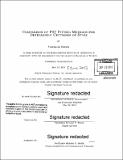Comparison of PSF fitting methods for determining centroids of stars
Author(s)
Gibson, Stephanie, S.B. Massachusetts Institute of Technology
DownloadFull printable version (4.570Mb)
Alternative title
Comparison of point-spread function fitting methods for determining centroids of stars
Other Contributors
Massachusetts Institute of Technology. Department of Earth, Atmospheric, and Planetary Sciences.
Advisor
Richard P. Binzel.
Terms of use
Metadata
Show full item recordAbstract
This paper shows a comparison of four fitting models used in order to calculate the centroids for twelve stars. The offsets for each coordinate are calculated with respect to the mean of the coordinates for varying aperture sizes. The computed offsets are then compared to determine if there was any effect from the magnitude of the star or the star's position on the CCD chip. An appropriate aperture size of 12 pixels is chosen in order to compare each method. It is determined that a magnitude effect exists, though it is very small and results in an approximate difference between residuals of between 0.02 and 0.04 pixels, which for most methods is within the fitting error. For the position on the chip effect, the vectors of the x and y residuals are produced in vector plots in order to demonstrate the directional tendency each fitting method had dependent on chip position. Each model has some dependency on position on the CCD chip, with 0.033 pixels as the largest variation between models. Therefore, for accuracy less than 0.033 pixels any of these models can be used for fitting a PSF to a star. However, if greater accuracy is needed more steps need to be taken in order to determine the best PSF fit.
Description
Thesis: S.B., Massachusetts Institute of Technology, Department of Earth, Atmospheric, and Planetary Sciences, 2013. Cataloged from PDF version of thesis. Includes bibliographical references (page 45).
Date issued
2013Department
Massachusetts Institute of Technology. Department of Earth, Atmospheric, and Planetary SciencesPublisher
Massachusetts Institute of Technology
Keywords
Earth, Atmospheric, and Planetary Sciences.